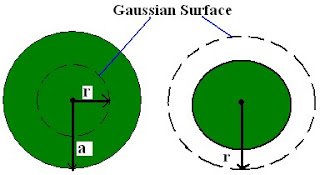Application Of Gauss Law To A Uniformly Charged Sphere - Field Theory.
- Consider a sphere of radius “a” having a uniform volume charge density of ρo C/m3.
- Gaussian surface selected for a symmetric sphere charge is a sphere itself.
- Here we consider two cases:
- A Gaussian surface with a radius r < a.
- A Gaussian surface with a radius r > a.
CASE 1:
If r < a (consider the 1st figure), the total charge enclosed by the Gaussian surface is:
Electric flux is given as:
Here ds is taken to be a function of θ and φ( since the surface is a hollow sphere).
Gauss law states that Ψ = Qenc
Therefore,
Dr 4π r2 = (4 / 3) (ρo πr3)
Or
D = (r / 3) ρo ar (0 < r < a)
CASE II:
If r > a (consider the above figure), the total charge enclosed by the Gaussian surface is:
Electric flux is given as:
Gauss law states that Ψ = Qenc
Therefore,
Dr 4π r2 = (4 / 3) (ρo πa3)
Or
D = (a3 / 3r2 ) ρo ar (r > a)
ALSO READ:
- Gauss's Law - Theory.
- Gauss's Law - Application To a Point charge.
- Gauss's Law - Application To An Infinite Line Charge.
- Gauss's Law - Application To An Infinite Sheet Charge.
- Gauss's Law - Application To a Uniformly Charged Sphere.
- Numericals / Solved Examples - Gauss's Law.
- Scalar Electric Potential / Electrostatic Potential (V).
- Relationship Between Electric Field Intensity (E) and Electrostatic Potential (V).
- Electric Potential Due To a Circular Disk.
- Electric Dipole.
- Numericals / Solved Examples - Electric Potential and Electric Dipole.
- Energy Density In Electrostatic Field / Work Done To Assemble Charges.
- Numericals / Solved Examples - Electrostatic Energy and Energy Density.
- Numericals / Solved Examples - Gauss's law...
Your suggestions and comments are welcome in this section. If you want to share something or if you have some stuff of your own, please do post them in the comments section.







Comments
Post a Comment